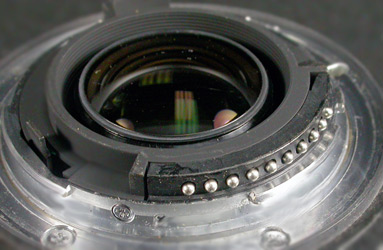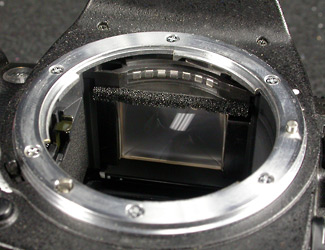I purchased a Nikon D70 for my first foray in to the SLR digital world. Overall a pretty good camera for desktop and outdoor photography Matched with the 105mm Nikon Macro lens you can accomplish some nice desktop work. Nikon also provides an Infra Red remote control for this camera which makes it easy to tripod mount and remotely operate minimizing vibration. (A mirror lock up would be nice, but I can live without it.)
BUT ... now for the bad news. First, when the remote sensor is turned on in the camera it will not stay on! It turns itself off in one minute. Unfortunately I often set the camera up on tripod and prepare to shoot multiple exposures of multiple subjects. Once the camera settings are fixed, I really don't want to touch it again while shooting. But if I fail to get the next sample in place within 60 seconds I have to depress a button on the left side of the body and rotate a wheel on the right side to turn on the remote again. Doesn't sound like a big deal but wait until you shoot 50 or 60 items in a row and have to turn the remote back on almost every-time.
Now for the biggie! The D70 will not meter without a Nikon (or made for Nikon) lens attached. The metering shuts down when no lenses are attached. So how often do you shoot without a lens you say! Well the SLR type of camera is designed to work with a third-tube microscope without a lens! Normally you connect an SLR camera to the third-tube assembly using a simple T-adapter. The T-adaper for the Nikon works fine, and it will connect the camera to the scope, but the meter shuts down.
 |
 |
|
Electronic contacts on Nikon lens
|
Contacts in Camera that match up
|
This also means that the Nikon D70 will not work with any bellows attachments for ultra closeup work as there are none designed to have the electronic contacts that are required to maintain connection to the correct lens types. Although there are "special" extension tubes available that will couple some lenses with the D70, older varieties will fit, but not work. Another method of doing high quality closeup photography is a lens reversing ring. Take a standard lens and use a T-adapter with the appropriate screw-in filter type, and the lens can be reversed on the camera body. This produces an excellent macro lens, although it is a bit dangerous when the internal optics are exposed in the process. This too fails with the D70.
Frankly there is no reason that the camera meter needs to shut down. Nikon claims they want information feedback from the lens to meter properly ... that's BS! Once an image is focused on the mirror system, the light can be read and metered The only thing needed by a metering system in all but complete auto mode is the ASA equivalent of the film or in the case of digital camera the equivalent speed of the ccd.
In some auto modes, the camera likes to know the range of f-stops that the lens can deliver, and the metering system makes use of this information In pure manual mode the camera still meters when an appropriate lens is attached. It just stops metering when the lens is removed. Sorry Nikon, you still need only two of the three changeable values to calculate proper exposure, film/ccd speed, aperture, and shutter speed.
I also heard the argument that Nikon cannot support the consumer level cameras with microscopes, too much technical support required Then why did they previously recommend and sell their Coolpix series with their own scopes?
 |
 |
|
Histogram of reasonable exposure on LCD of D70
|
D70 on scope
|
There are work arounds. You can set the LCD display to show a histogram of the image (see photo above) when the camera defaults to manual - no metering mode. You can shot a series of images using the histogram as a "pseudo-metering system". Shot an image and look at the histogram, then adjust the shutter speed accordingly and shot another image looking at the resultant histogram. Once the histogram is roughly centered within its range the exposure is pretty close.